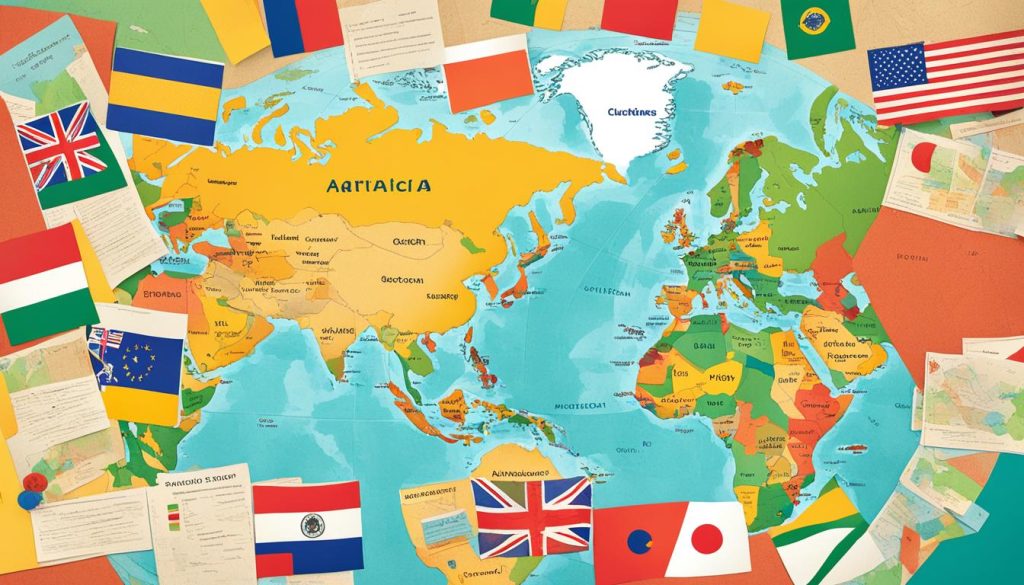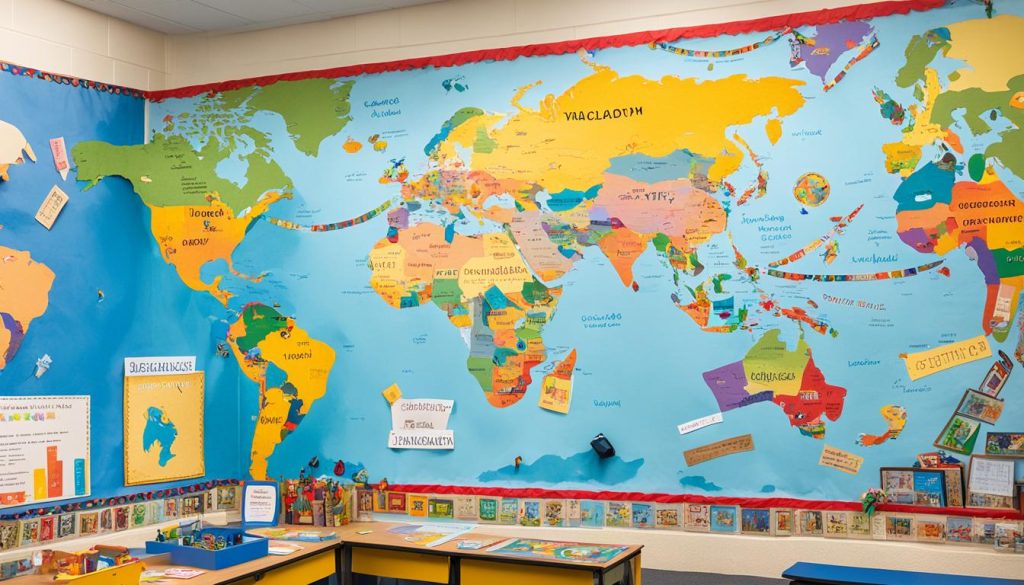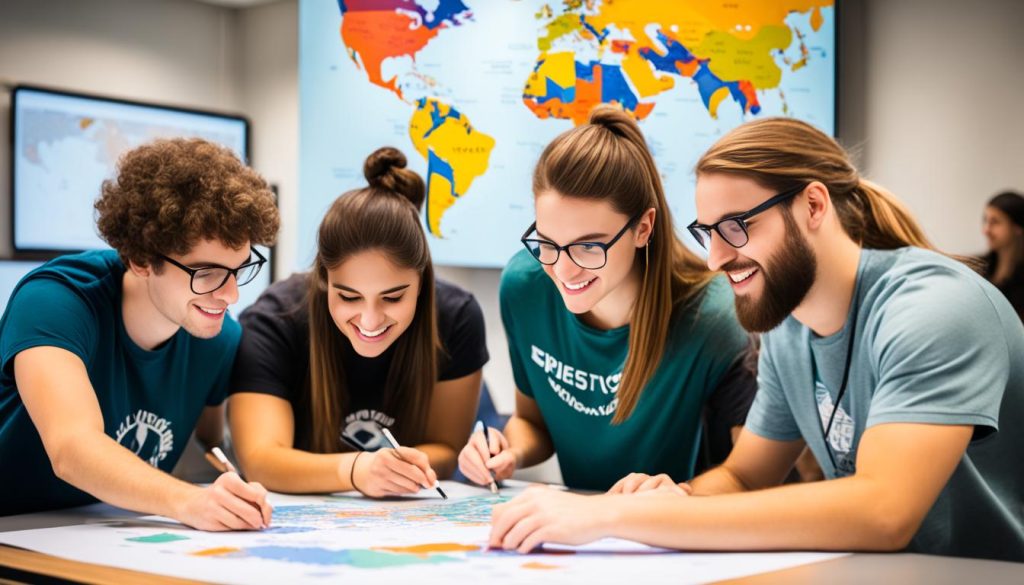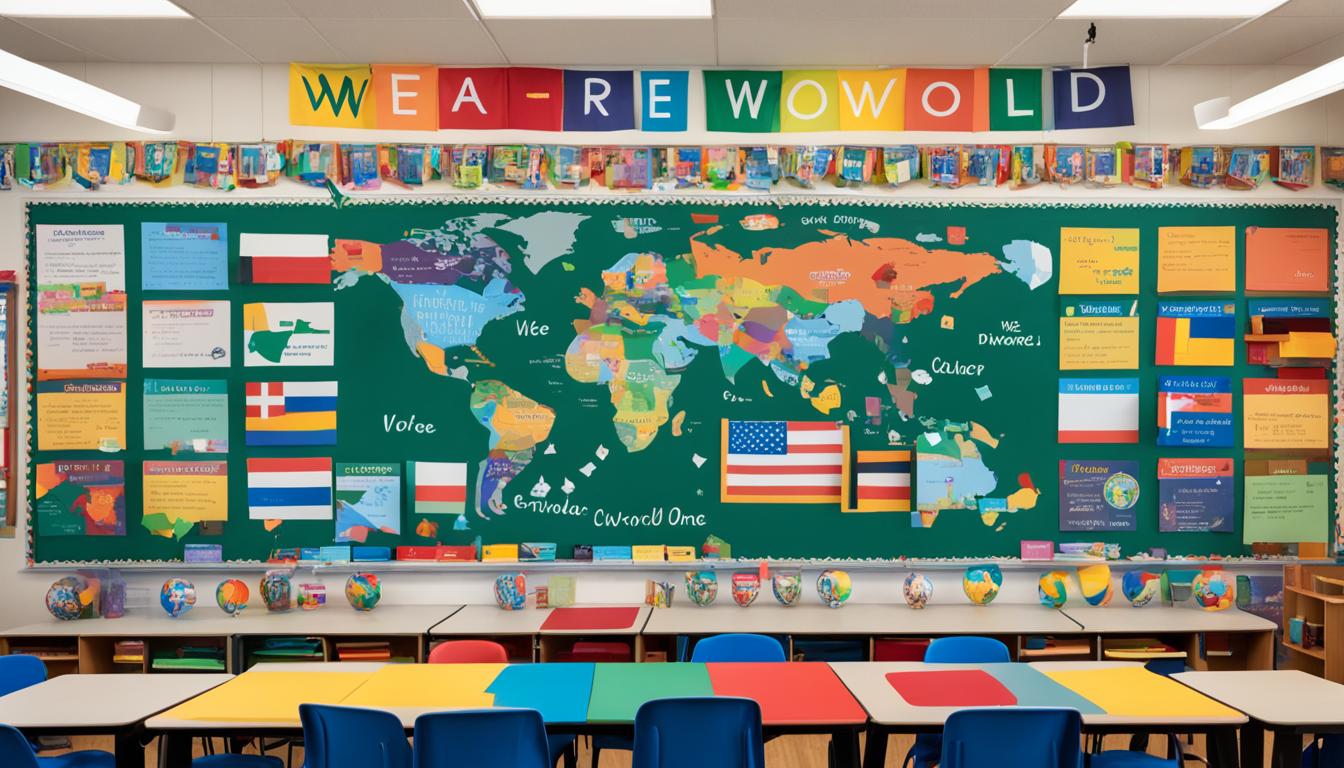In the United States, students spend the majority of their day under the care of adults who are not their parents or guardians. These school-based adults assume the responsibility of caregiver for children who are not their own. The cultural upbringing of the teachers and the cultural upbringing of the students form an intersection that is critical to the academic success of the students and the professional success of the adults. It’s imperative that students and teachers know each other beyond the subjective cultural experiences that each may bring to the classroom, and that educators possess an understanding of diverse cultures but not stereotype people into a one-size-fits-all cultural mold. Students need to be related to as full, complex, multidimensional people.
Key Takeaways
- Recognize the importance of cross-cultural competence in the classroom
- Foster international collaboration and global citizenship among students
- Incorporate diverse perspectives and multicultural literacy into the curriculum
- Promote a classroom environment that celebrates diversity and inclusion
- Prepare students to thrive in an increasingly interconnected, globalized world
Understanding the Importance of Cultural Diversity in Education
As the United States becomes increasingly diverse, with the Census Bureau projecting that by 2020 more than half of all students in US public schools will be minority students, educators must adapt to meet the needs of students from a wide range of cultural, economic, and linguistic backgrounds. Developing cross-cultural competency, fostering an international mindset, and promoting multicultural literacy have become essential for creating an inclusive learning environment and diversity in the classroom.
Cultural Shifts in the Classroom
Figuring out how to address the diverse needs of students and resolve potential cultural differences between them has become a top priority for educators. Teachers must possess a deep understanding of cultural and linguistic differences as well as achievement gaps in order to create a classroom environment where all students can thrive.
Minority Majority Milestone in U.S. Public Schools
The impending “minority majority” milestone in US public schools represents a significant cultural shift that requires a proactive response from the education system. Educators must be prepared to cultivate an international mindset and cross-cultural competency among their students to prepare them for success in an increasingly diverse society.
Preparing Students for an Increasingly Diverse Society
As the classroom becomes more reflective of the broader diversity within society, it is essential that educators focus on developing students’ multicultural literacy and equipping them with the skills to navigate an inclusive learning environment. This involves addressing diversity in the classroom and fostering an appreciation for different cultural perspectives.
Dimensions of Cultural Diversity in the Classroom
In the modern classroom, students come from a wide variety of cultural backgrounds, each with their own unique experiences, perspectives, and needs. To foster a truly inclusive and supportive learning environment, teachers must understand the different dimensions of cultural diversity that may be present in their classrooms. This includes factors such as race, ethnicity, religion, language, socioeconomic status, sexual orientation, and gender identity.
Race and Ethnicity
Racial and ethnic diversity is a significant aspect of cultural diversity in the classroom. Students from different racial and ethnic backgrounds may have varying beliefs, traditions, and communication styles that can impact their educational experiences. Recognizing and respecting these differences is crucial for creating a welcoming and inclusive classroom that celebrates the worldwide perspectives of all students.
Religion and Language
Religious and linguistic diversity also play a important role in shaping a student’s cultural identity and their intercultural communication within the classroom. Students may hold different religious beliefs or speak various native languages, which can influence their learning styles, participation, and overall sense of belonging. Accommodating and appreciating these diverse backgrounds is essential for promoting cultural diversity and understanding in the classroom.
Socioeconomic Status and Gender Identity
Additionally, a student’s socioeconomic status and gender identity can significantly impact their educational experiences and access to resources. Students from lower-income backgrounds or those who identify with types of cultural diversity such as LGBTQ+ may face unique challenges and barriers in the classroom. Addressing these factors with sensitivity and providing equitable support is vital for ensuring all students have the opportunity to thrive.

By understanding the multifaceted nature of cultural diversity in the classroom, teachers can develop more effective strategies for creating an inclusive and enriching learning environment that celebrates the unique strengths and experiences of every student.
Fostering Culturally Responsive Teaching Practices
Cultivating a culturally responsive teaching approach is essential for creating an engaging and accessible learning environment for students from diverse backgrounds. The first step in this process is to assess your own personal biases and attitudes, and actively work to shift your mindset toward a more culturally inclusive and open-minded perspective.
Assessing Personal Biases and Attitudes
Becoming aware of your own inherent biases and preconceptions is the foundation for developing cultural intelligence in education. Reflect on your own cultural experiences, beliefs, and assumptions, and how they may influence your interactions with students. Challenge yourself to identify and address any prejudices or stereotypes that could hinder your ability to connect with and support learners from various cultural backgrounds.
Building Relationships with Students and Families
Alongside examining your personal biases, it’s crucial to proactively build genuine relationships with your students and their families. Take the time to get to know each student as an individual, learning about their unique cultural experiences, interests, and learning styles. Reach out to parents and caregivers to better understand the home lives and cultural contexts of your students, fostering a collaborative teacher professional development approach.
Creating an Inclusive and Welcoming Classroom Environment
To foster an inclusive and welcoming classroom environment, it is essential to encourage open dialogue and critical thinking, rather than judgment. Students should feel comfortable exploring cultural situations with an unbiased opinion and be empowered to ask questions that further their understanding. By creating a safe, judgment-free zone, you can cultivate a classroom where all students feel respected and celebrated for their unique backgrounds and perspectives.
Encouraging Open Dialogue and Critical Thinking
Promoting open dialogue and critical thinking is key to nurturing an inclusive classroom. Encourage your students to engage in thoughtful discussions, share their diverse viewpoints, and challenge assumptions without fear of ridicule or criticism. This open exchange of ideas not only deepens their understanding of culturally responsive teaching strategies but also fosters a sense of belonging and trust among your students.
Respecting and Celebrating Diversity
As an educator, it is your responsibility to actively work towards respecting and celebrating the diversity and inclusion within your classroom. Incorporate your students’ unique backgrounds, cultures, and perspectives into your lessons and classroom activities. Acknowledge and honor the richness that their diverse experiences bring, empowering them to share and learn from one another. By fostering an environment that values and celebrates differences, you can create a truly inclusive learning experience for all.
Adapting Curriculum and Instruction for Cultural Responsiveness
Culturally responsive teaching is a student-focused approach that identifies the differences between students and the unique strengths of each child to encourage their academic achievement and a sense of belonging in the classroom. This requires adapting the curriculum and instructional approaches to incorporate multicultural perspectives and utilize more interactive and collaborative learning strategies that engage students of all cultural backgrounds.
Incorporating Multicultural Perspectives
By incorporating multicultural perspectives into the curriculum, you can help students develop a deeper understanding and appreciation for diverse cultures, histories, and experiences. This may involve incorporating literature, art, and media from a range of cultural backgrounds, as well as highlighting the contributions of underrepresented groups throughout history.
Utilizing Interactive and Collaborative Learning Strategies
Student-centered teaching approaches, such as project-based learning, group discussions, and experiential activities, can create more engaging and inclusive learning environments for students from diverse cultural backgrounds. These interactive and collaborative learning strategies encourage students to share their unique perspectives, work together, and actively participate in the learning process.

Ultimately, adapting the curriculum and instruction to reflect culturally responsive practices is essential for creating a learning environment that empowers and supports students from all cultural backgrounds. By embracing multicultural perspectives and utilizing interactive, student-centered approaches, you can foster a more inclusive and engaging classroom that celebrates diversity and prepares students to thrive in our increasingly globalized world.
Education for a Global World
As our world becomes increasingly globalized, it is essential that education prepares students to thrive in a diverse, interconnected world. This requires fostering an international mindset, developing global citizenship skills, and building worldwide networks and collaborations.
By cultivating an international mindset, students can gain a deeper understanding of diverse cultures, perspectives, and experiences. This empowers them to navigate our globalized society with greater cultural awareness and sensitivity, ultimately becoming more globally-minded citizens.
Developing global citizenship skills is equally crucial, as it equips students with the knowledge, values, and behaviors necessary to actively participate in and contribute to our worldwide community. These skills include cross-cultural communication, conflict resolution, and a commitment to sustainable development and social justice.
Furthermore, building worldwide networks and collaborations opens up a world of possibilities for students. By engaging in international exchange programs, virtual global partnerships, and collaborative projects, they can expand their horizons, forge meaningful connections, and develop a deeper appreciation for the diversity that exists globally.
Ultimately, education for a global world empowers students to thrive in our interconnected and increasingly diverse society. By fostering an international mindset, cultivating global citizenship skills, and facilitating worldwide collaborations, educators can prepare the next generation to lead and succeed in our globalized world.
Promoting Intercultural Communication and Understanding
Fostering intercultural communication and understanding is a pivotal aspect of creating a classroom that reflects a global worldview. This multifaceted approach involves encouraging cross-cultural exchanges and collaborations between students, as well as developing their global citizenship skills and cultural competence. By cultivating these capabilities, you can empower students to thrive in our increasingly diverse and interconnected world.
Encouraging Cross-Cultural Exchanges and Collaborations
Promote opportunities for your students to engage in meaningful cross-cultural exchanges and collaborative projects. These experiences not only enhance their intercultural communication abilities but also foster a deeper appreciation for diverse perspectives and shared experiences. Consider organizing cultural festivals, language exchange programs, or joint learning activities that bring together students from different backgrounds to work towards common goals.
Developing Global Citizenship and Cultural Competence
Equip your students with the knowledge and skills to become global citizens. Incorporate lessons and activities that build their cultural competence, enabling them to navigate diverse cultural contexts with empathy, adaptability, and respect. Encourage students to explore global issues, engage in cross-cultural dialogues, and develop a nuanced understanding of the world beyond their immediate surroundings.

By promoting intercultural communication and fostering global collaboration within your classroom, you can empower your students to thrive in an increasingly interconnected world. Nurturing these critical capabilities will prepare them to effectively navigate and contribute to our diverse, globalized society.
Integrating Global Perspectives into Lesson Plans
As the world becomes increasingly interconnected, it is crucial to integrate worldwide perspectives into your lesson plans, exposing students to diverse viewpoints and real-world global issues. This can be achieved by leveraging a range of international resources and inviting guest speakers from varied cultural backgrounds to share their knowledge and experiences.
Utilizing International Resources and Guest Speakers
Incorporate multimedia resources, such as videos, podcasts, and articles, that showcase different cultures, traditions, and global events. Carefully curate these materials to ensure they provide a balanced and accurate representation of the worldwide perspectives you want to highlight. Additionally, reach out to local and international organizations, embassies, or universities to invite guest speakers who can offer unique insights and enrich your students’ understanding of diverse global issues.
Addressing Global Issues and Challenges
Integrate discussions and activities that explore pressing global issues, such as sustainability, human rights, international conflicts, and public health. Encourage your students to critically analyze these complex challenges from multiple angles, fostering their ability to think critically and develop empathy for different worldviews. By addressing global issues within your curriculum, you can empower your students to become more engaged and informed global citizens.

Building Cross-Cultural Connections and Partnerships
Beyond the classroom, building cross-cultural connections and partnerships is essential for creating a global learning environment. This includes fostering international educational collaborations, such as student/teacher exchanges and joint projects, as well as engaging with diverse local and global communities and organizations. These types of connections and partnerships help strengthen students’ intercultural understanding and expose them to diverse perspectives.
Fostering International Educational Collaborations
One key way to build global collaboration is by fostering international educational partnerships. This could involve setting up student or teacher exchange programs, where learners have the opportunity to immerse themselves in different cultural contexts and learn from their international peers. Additionally, schools can collaborate on joint projects and research initiatives, bringing together diverse communities to tackle global challenges and share knowledge across borders.
Engaging with Diverse Communities and Organizations
Beyond traditional educational exchanges, it’s also important to engage with a wide range of local and global communities and organizations. This could include inviting guest speakers from international backgrounds to share their experiences, or partnering with community groups and non-profits that specialize in cross-cultural initiatives. By fostering these connections, you can expose students to a wealth of worldwide perspectives and help them develop a deeper understanding of the diversity that exists in our interconnected world.

Embracing Diversity in the Classroom and Beyond
Ultimately, embracing diversity in the classroom and beyond is crucial for preparing students to succeed in an increasingly globalized world. This involves promoting equity and inclusion for all students, regardless of their cultural background, and equipping them with the global competence and intercultural skills needed to navigate an interconnected, diverse society. By fostering this inclusive mindset, educators can empower students to thrive in our multicultural world.
Promoting Equity and Inclusion for All Students
Creating an equitable and inclusive classroom environment is essential for supporting the academic and personal growth of students from diverse backgrounds. This requires acknowledging and addressing systemic inequities, ensuring all learners have access to the resources and opportunities they need to succeed. Educators must also celebrate the unique experiences and perspectives that each student brings to the classroom, fostering a sense of belonging and validating their identities.
Preparing Students for Success in a Globalized World
As the world becomes increasingly interconnected, it is vital that students develop the global competence and intercultural skills necessary to navigate and thrive in our diverse, multicultural society. This involves exposing students to worldwide perspectives, facilitating cross-cultural exchanges and collaborations, and equipping them with the knowledge and capabilities to engage effectively with people from diverse backgrounds. By embracing diversity, educators can better prepare students to contribute to and succeed in our global community.
Conclusion
In conclusion, creating a classroom that reflects a global worldview requires a multifaceted approach. This approach must address cultural diversity, foster culturally responsive teaching practices, develop intercultural communication and understanding, and integrate worldwide perspectives throughout the curriculum and learning environment. By embracing diversity and cultivating global citizenship in their students, educators can better prepare the next generation to succeed in our interconnected world.
Implementing this comprehensive strategy is crucial for equipping students with the skills and mindset needed to thrive in our increasingly diverse and globalized society. Through a focus on international education and a commitment to inclusive, culturally responsive teaching, educators can empower their students to navigate the complexities of our interconnected world with confidence and cultural competence.
By prioritizing these key elements, you can create a learning environment that celebrates the richness of diverse perspectives and prepares your students for success in an ever-changing global landscape. Embrace the opportunity to foster a global worldview in your classroom and unlock the boundless potential of your students as they embark on their journey to become engaged, informed, and culturally aware global citizens.
FAQ
What is the significance of cultural diversity in the classroom?
How is the demographic makeup of U.S. public schools changing?
What are the different aspects of cultural diversity that teachers should be aware of?
What is culturally responsive teaching, and why is it important?
How can teachers foster an inclusive and welcoming classroom environment?
How can teachers adapt their curriculum and instruction to be more culturally responsive?
Why is it important for education to have a global worldview?
How can teachers promote intercultural communication and understanding in the classroom?
What are some ways to integrate global perspectives into lesson plans?
How can schools build cross-cultural connections and partnerships?
Source Links
- https://www.edutopia.org/article/classroom-where-everyone-feels-welcome/
- https://drexel.edu/soe/resources/student-teaching/advice/importance-of-cultural-diversity-in-classroom/
- https://www.teachaway.com/blog/5-steps-becoming-culturally-responsive-teacher

